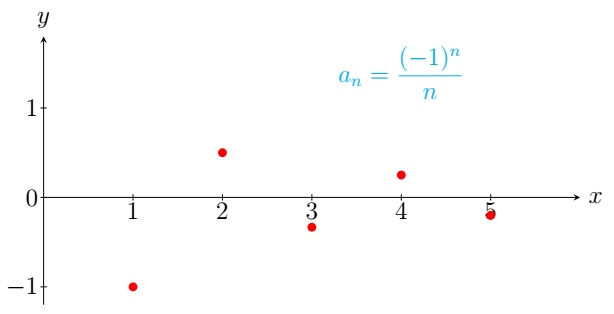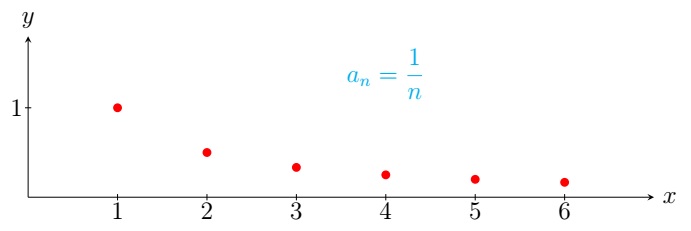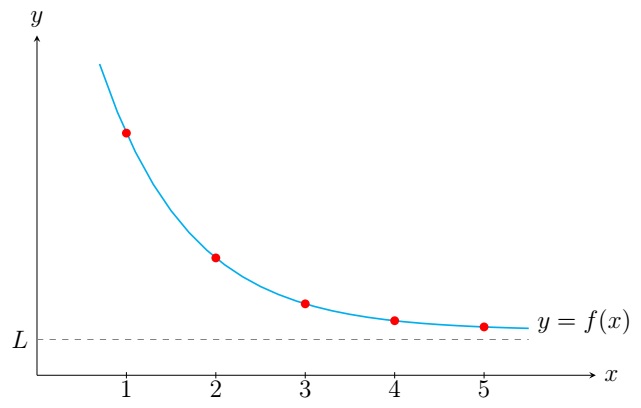
Sequences |
A sequence \(\{a_n\}\) of real numbers is a function \(f:\mathbb N\to \mathbb R\) such that \(f(n)=a_n\). Sometimes it is denoted by \(\{a_n\}_{n=1}^{\infty}\) or by a few terms with a certain pattern \(\{a_1,a_2,a_3,\ldots\}\). A sequence can also be defined recursively.

Example.
Definition. A sequence \(\{a_n\}\) converges to a real number \(L\) if \(x_n\) can be made arbitrarily close to \(L\) by taking sufficiently large \(n\) (for details, see the \(\varepsilon-N\) definition). It is denoted by \(\displaystyle\lim_{n\to \infty} a_n=L\) or \(a_n\to L\) as \(n\to \infty\). The sequence \(\{a_n\}\) diverges if it is not convergent.

Example.
Note that if a sequence \(\{x_n\}\) diverges, its terms oscillate indefinitely like that of \(\{(-1)^n\}\) or it diverges to \(\pm \infty\).
Theorem. If \(a_n=f(n)\) for all integers \(n\geq 1\) and \(\displaystyle\lim_{x\to \infty} f(x)=L\), then \(\displaystyle\lim_{n\to \infty} a_n=L\).

Example.
Show that \(\displaystyle\lim_{n\to \infty} \frac{n+\tan^{-1}n}{n}=1\).
Solution. Let \(f(x)=\displaystyle\frac{x+\tan^{-1}x}{x}\). Note that \(f(n)\) is the \(n\)th term
of the sequence \(\left\lbrace \displaystyle\frac{n+\tan^{-1}n}{n} \right\rbrace\).
\[ \displaystyle\lim_{x\to \infty} f(x)=
\displaystyle\lim_{x\to \infty} \frac{x+\tan^{-1}x}{x}
= \displaystyle\lim_{x\to \infty} \frac{1+\frac{1}{1+x^2}}{1} =1
\;\;\left(\text{by l'Hospitals's Rule} \right). \]
Thus \(\displaystyle\lim_{n\to \infty} \frac{n+\tan^{-1}n}{n}=1\), i.e., the sequence
\(\left\lbrace \displaystyle \frac{n+\tan^{-1}n}{n} \right\rbrace\) converges to \(1\).
Algebra of limits for sequences:
Theorem.
The following are true for any convergent sequences \(\{a_n\}\) and \(\{b_n\}\):
Note that the convergence in the assumption is crucial. For \(\{a_n\}=\{\frac{1}{n}\}\) and \(\{b_n\}=\{n\}\), we have \(\{a_nb_n\}=\{1\}\). But \[\displaystyle\lim_{n\to \infty} a_nb_n=1\neq 0\cdot \infty\ =\left(\displaystyle\lim_{n\to \infty} a_n \right) \left(\displaystyle\lim_{n\to \infty} b_n\right).\]
Example.
Determine if the sequence \(\{a_n\}\) converges or diverges.
(a) \(a_n=\displaystyle\frac{n^3}{n^3+1}\), (b) \(a_n=\displaystyle\frac{n^3}{n+1}\), (c) \(a_n=\displaystyle\sqrt{\frac{n+1}{9n+1}}\).
Solution. (a) \(\displaystyle\lim_{n\to \infty} a_n=\displaystyle\lim_{n\to \infty}\frac{n^3}{n^3+1}
=\displaystyle\lim_{n\to \infty}\frac{1}{1+\frac{1}{n^3}}
=\displaystyle\frac{1}{1+\displaystyle\lim_{n\to \infty}\frac{1}{n^3}}
=\displaystyle\frac{1}{1+0}
=1.\)
Thus \(\left\lbrace \displaystyle\frac{n^3}{n^3+1} \right\rbrace\) converges to \(1\).
(b) \(\displaystyle\lim_{n\to \infty} a_n=\displaystyle\lim_{n\to \infty}\frac{n^3}{n+1}
=\displaystyle\lim_{n\to \infty}\frac{n^2}{1+\frac{1}{n}}
=\infty.\)
Thus \(\left\lbrace \displaystyle\frac{n^3}{n+1} \right\rbrace\) diverges to \(\infty\).
(c) \(\displaystyle\lim_{n\to \infty} a_n
=\displaystyle\lim_{n\to \infty}\sqrt{\frac{n+1}{9n+1}}
=\displaystyle\sqrt{ \displaystyle\lim_{n\to \infty}\frac{n+1}{9n+1}}
=\displaystyle\sqrt{ \displaystyle\lim_{n\to \infty}\frac{1+\frac{1}{n}}{9+\frac{1}{n}}}
=\displaystyle\sqrt{ \frac{1+0}{9+0}}
=\frac{1}{3}.\)
Thus \(\left\lbrace \displaystyle\sqrt{\frac{n+1}{9n+1}} \right\rbrace\) converges to \(\frac{1}{3}\).
Theorem. If \(\{a_n\}\) is convergent and \(f\) is a continuous function, then \[\displaystyle\lim_{n\to \infty} f(a_n)=f\left( \displaystyle\lim_{n\to \infty} a_n \right).\]
Example. Since \(f(x)=\cos x\) is a continuous function, \[\displaystyle\lim_{n\to \infty} \cos\left( \frac{2}{n} \right)=\cos\left( \displaystyle\lim_{n\to \infty} \frac{2}{n} \right)=\cos 0=1.\] Thus \(\left\lbrace \cos\left( \frac{2}{n} \right) \right\rbrace\) converges to \(1\).
Theorem.(Sandwich Theorem) Suppose \(a_n\leq b_n\leq c_n\) for all natural numbers \(n\). If both \(\{a_n\}\) and \(\{c_n\}\) converge to \(L\), then \(\{b_n\}\) also converges to \(L\).
Example.
Show that \(\displaystyle\lim_{n\to \infty} \frac{\sin(3n)}{n}=0\).
Solution. First note that \(-1\leq \sin(3n) \leq 1\) for all real numbers \(n\). Then for all natural
numbers \(n\),
\[-\frac{1}{n}\leq \frac{\sin(3n)}{n} \leq \frac{1}{n}.\]
Since \(\displaystyle\lim_{n\to \infty} \frac{-1}{n}=\displaystyle\lim_{n\to \infty} \frac{1}{n}=0\), we have
\(\displaystyle\lim_{n\to \infty} \frac{\sin(3n)}{n}=0\) by the Sandwich Theorem.
As consequences of the Sandwich Theorem, we have the following results:
Example.
(a) Since \(\displaystyle\lim_{n\to \infty} \left| \frac{(-1)^n}{n} \right|=\displaystyle\lim_{n\to \infty} \frac{1}{n}=0\),
\(\displaystyle\lim_{n\to \infty} \frac{(-1)^n}{n}=0\).
(b) \(\displaystyle\lim_{n\to \infty} \frac{2^n(-1)^n}{3^n}=\displaystyle\lim_{n\to \infty} \left( -\frac{2}{3} \right)^n=0\)
as \(-1<-\frac{2}{3}\leq 1\). But \(\displaystyle\lim_{n\to \infty} \left(\frac{3}{2} \right)^n\) does not exist as
\(\frac{3}{2}>1\).
Definition. A sequence \(\{a_n\}\) is bounded if there exists a real number \(M\) such that \(|a_n|\leq M\) for all natural numbers \(n\).
Example. \(\{\frac{1}{n}\}\) is bounded since \(|\frac{1}{n}|\leq 1\) for all natural numbers \(n\).
Theorem. A convergent sequence is bounded.
Definition. A sequence \(\{a_n\}\) is increasing if \(a_{n+1} > a_n\) for all natural numbers \(n\) and decreasing if \(a_{n+1}< a_n\) for all natural numbers \(n\).
Theorem.(Monotone Convergence Theorem)
Note that the Monotone Convergence Theorem is also true for non-decreasing and non-increasing sequences respectively.
Example.
Last edited